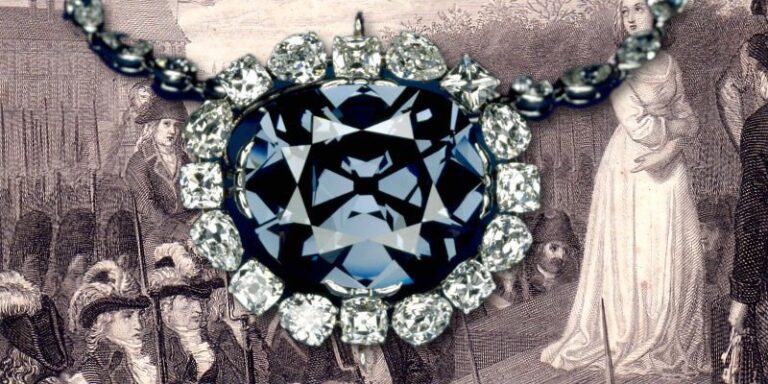In the dazzling world of gemstones, few can rival the Hope Diamond in both beauty and infamy. This 45.52-carat blue diamond has long held the spotlight as the world’s most famous gem. But what truly sets the Hope Diamond apart is the cloak of superstition, tragedy, and mystery that shrouds it in legend. The legend of the Hope Diamond’s curse is a story that has captured the human imagination, leaving us to ponder whether it’s based on factual misfortune or merely the stuff of fanciful fiction.
Picture a gemstone of rare beauty, discovered in the Golconda mines of India during the 17th century. A diamond that once adorned the crowns of French royalty, only to pass through the hands of nobles, merchants, and collectors. A diamond that, despite its resplendent blue hue, has been haunted by stories of ill fate and misery.
Is the Hope Diamond truly cursed, or is it a creation of overactive imaginations and sensational storytelling? Join us on a journey through the facets of this captivating gem’s story as we delve deep into the lore, the history, and the enduring enigma that is the Hope Diamond. In exploring the tales, the truths, and the many shades of blue that make up the legacy of this extraordinary gem, we aim to unravel the enigmatic riddle that has intrigued generations.
The Diamond’s Origin

Our tale begins with the stone itself—a 45.52-carat blue diamond known today as the Hope Diamond. It is a gem of rare beauty and remarkable size, often described as the world’s most famous diamond. But its story goes beyond its stunning appearance; it is a tale of myth, majesty, and mystery.
The Hope Diamond’s origins can be traced to the Golconda mines of India, where it was likely discovered in the 17th century. Its original rough weight is estimated to have been around 112 carats. From the moment it was unearthed, it was clear that this diamond was extraordinary. Its striking blue hue, due to the presence of trace amounts of boron, sets it apart from other diamonds.
The diamond’s journey took it from India to France, where it adorned the crown of Louis XIV. It later passed through the hands of nobles, including Louis XVI and Marie Antoinette, before eventually leaving France during the turbulent times of the French Revolution.
In the early 19th century, the gem made its way to London, where it became known as the “Hope Diamond,” named after Henry Thomas Hope, one of its owners. The diamond would go on to change hands multiple times, with each owner adding a layer of legend and lore to its already fascinating history.
The Myth of the Curse
The notion of the Hope Diamond being cursed can be traced back to its time in France. Legend has it that the diamond was stolen from the eye of a sacred statue of the Hindu goddess Sita and that a curse would befall all who possessed it. While there is no concrete evidence to support this story, it sowed the seeds of superstition.
The curse gained momentum in the 19th century with the rise of sensational journalism. Newspapers and magazines began to embellish stories of misfortune befalling the diamond’s owners. Tales of financial ruin, broken relationships, and even untimely deaths were linked to the Hope Diamond’s curse.
One of the most enduring stories of the curse revolves around a man named Francis Thomas Hope. As the diamond’s owner in the late 19th century, he was said to have faced a series of calamities, from marital strife to financial difficulties. The diamond passed out of the Hope family’s possession, and the curse seemed to have been temporarily lifted.
The Smithsonian Era
In 1958, jeweler Harry Winston donated the Hope Diamond to the Smithsonian Institution, where it remains on display today. Interestingly, since the diamond’s arrival at the Smithsonian, the supposed curse seems to have lost its grip. Visitors flock to see the Hope Diamond, often taking photographs and marveling at its captivating beauty.
Some have suggested that the curse was a product of sensationalist storytelling and superstition. Others believe that the diamond’s relocation to a place of scientific study and public admiration has removed the negative energy associated with it.
The Science of Cursed Gemstones
Superstitions and beliefs in curses are as old as human history. They often arise in situations where events are difficult to explain or control. With the Hope Diamond, the string of misfortunes could be interpreted as coincidences or the natural ebb and flow of life’s ups and downs. When we believe in curses, we might subconsciously create self-fulfilling prophecies. This is a psychological phenomenon known as the “nocebo effect,” where belief in harm can lead to negative outcomes.
The Hope Diamond’s True Value
When we look past the curse, we see the Hope Diamond for what it truly is—an extraordinary gem of unparalleled beauty. Its dazzling blue color, clarity, and size make it a rare and precious treasure.
But the diamond’s real value goes even deeper. It has played a role in scientific research, helping scientists understand the geological processes that create blue diamonds. The Hope Diamond’s journey from India to Europe and, eventually, to the Smithsonian provides a fascinating glimpse into the world of gem trading and history.
The Hope Diamond’s mystique endures, captivating those who gaze upon its brilliant facets. Its legendary history, whether rooted in fact or myth, adds to its allure. The tales of a curse and misfortune are but one facet of the larger story—a story of human fascination, creativity, and the enduring power of a gemstone that has left its mark on the world.
The Hope Diamond Unveiled
As we approach the culmination of our expedition through the Hope Diamond’s captivating narrative, we find ourselves standing at a crossroads—a crossroads where the mists of time, belief, and human imagination intersect. The central question that has reverberated through the annals of history—whether the Hope Diamond is genuinely cursed or if its story has been embroidered with the threads of legend and folklore—may forever elude a definitive answer.
The Hope Diamond is not merely a gem; it is a testament to the intricate interplay of history and legend. It underscores the notion that stories, whether grounded in empirical reality or woven from the fabric of human imagination, possess a remarkable ability to transcend time and captivate generations. It is, in essence, a challenge, a conundrum, and an invitation for us to delve deeper into the intricacies of belief, the dynamics of superstition, and the timeless allure of an exquisite gemstone.
In our pursuit of truth, we are left with a remarkable jewel that encompasses numerous facets, each contributing to its enduring mystique. It prompts us to ponder the power of human belief, the mutable nature of superstition, and the timeless charm of a gem that has etched its enigmatic story into the annals of history. Whether it truly carries a curse or stands as an emblem of humanity’s fascination, the Hope Diamond stands as a testament to the enigmas that continue to defy easy classification, where history and legend converge in a brilliant display of the human experience.

